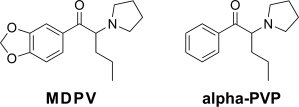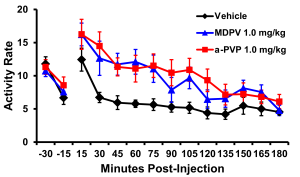In a prior post I briefly discussed the fact that alpha-PVP or “flakka” (sometimes “gravel”) has been in the news lately, due to being associated with bizarre behavior in users. A frequent theme of the news media reporting is that this drug is stronger or more dangerous than bathsalts. For examples see here, here, here, here. This one has the extra bonus of repeating the claim that the Causeway Cannibal was on bathsalts…forensic testing proved this initial claim from the police, repeated endlessly in the media, was not the case.
 As it happens, we conducted a study to compare these two drugs directly in rat models of locomotor stimulation, temperature disruption and self-administration. Alpha-PVP is structurally very similar to MDPV, as you can see in this figure. We were particularly intrigued by a report from Marusich et al (2014) which showed that alpha-PVP is less potent at inhibiting the dopamine transporter (a major pharmacological property of cocaine and the amphetamines) compared with MDPV. Correspondingly, the authors also showed alpha-PVP was less potent than MDPV in a mouse locomotor-stimulation test (but was able to increase locomotor activity to at least the same amount at a higher dose, showing similar efficacy). Another study by Naylor et al (2015) found that alpha-PVP fully substituted for methamphetamine in rats trained to distinguish methamphetamine from saline, but it was less potent than methamphetamine. We had previously shown [blog post, Aarde et al 2013, press account] that MDPV is more potent and effective than methamphetamine in rat self-administration. So initially we were predicting that MDPV would probably be more potent than alpha-PVP in a direct comparison study.
As it happens, we conducted a study to compare these two drugs directly in rat models of locomotor stimulation, temperature disruption and self-administration. Alpha-PVP is structurally very similar to MDPV, as you can see in this figure. We were particularly intrigued by a report from Marusich et al (2014) which showed that alpha-PVP is less potent at inhibiting the dopamine transporter (a major pharmacological property of cocaine and the amphetamines) compared with MDPV. Correspondingly, the authors also showed alpha-PVP was less potent than MDPV in a mouse locomotor-stimulation test (but was able to increase locomotor activity to at least the same amount at a higher dose, showing similar efficacy). Another study by Naylor et al (2015) found that alpha-PVP fully substituted for methamphetamine in rats trained to distinguish methamphetamine from saline, but it was less potent than methamphetamine. We had previously shown [blog post, Aarde et al 2013, press account] that MDPV is more potent and effective than methamphetamine in rat self-administration. So initially we were predicting that MDPV would probably be more potent than alpha-PVP in a direct comparison study.
A description of our study has recently been accepted for publication:
Shawn M. Aarde, Kevin M. Creehan, Sophia A. Vandewater, Tobin J. Dickerson and Michael
A. Taffe. In vivo potency and efficacy of the novel cathinone α-pyrrolidinopentiophenone and 3,4-methylenedioxypyrovalerone: Self-administration and locomotor stimulation in male rats, 2015, Psychopharmacology, in press. [PubMed, Publisher Link]
The study was conducted in separate groups of male rats originally trained to self-administer MDPV or alpha-PVP intravenously (0.05 mg/kg/inf in both cases) under a Fixed Ratio 1 contingency. This means each press of the drug-associated lever resulted in one drug infusion over the course of 20 sessions of 1 h duration. At the end of this interval the alpha-PVP rats were reaching mean intakes slightly higher than the MDPV rats, but these differences were mostly attributable to one or two animals in each group. The intake for the MDPV trained animals agreed quite well with our two previous studies [Aarde et al 2013, above; Aarde et al, 2014 Epub ahead of print] which involved a similar acquisition phase.
 In the following Progressive-Ratio dose-substitution procedure, the animals were permitted to respond for different infusion doses on different days. During the session within this procedure, each subsequent infusion of drug required an additional number of lever responses during the session. What I show in this figure (this study is represented by drug-associated lever-responses in the paper*) are the breakpoints achieved in a Progressive Ratio assay . The “breakpoint”, graphed here, reflects the mean number of responses required to obtain the final infusion the rats obtained on a given session. Doses were presented in random order across the groups (Significant differences from the 0.018 mg/kg/inf dose condition are signified by *, from the 0.032 dose by &, from the 0.056 dose by % and differences from the 0.56 dose by #.).
In the following Progressive-Ratio dose-substitution procedure, the animals were permitted to respond for different infusion doses on different days. During the session within this procedure, each subsequent infusion of drug required an additional number of lever responses during the session. What I show in this figure (this study is represented by drug-associated lever-responses in the paper*) are the breakpoints achieved in a Progressive Ratio assay . The “breakpoint”, graphed here, reflects the mean number of responses required to obtain the final infusion the rats obtained on a given session. Doses were presented in random order across the groups (Significant differences from the 0.018 mg/kg/inf dose condition are signified by *, from the 0.032 dose by &, from the 0.056 dose by % and differences from the 0.56 dose by #.).
As should be obvious, MDPV and alpha-PVP generated remarkably similar behavior. The peaks of the two curves are about the same, indicting that the maximum reinforcing effect of these drugs is similar. The curves also overlap across the entire dose range, suggesting that the potency of the drugs is similar.
 Additional data in the paper show that the doses of alpha-PVP and MDPV which produced the maximum locomotor stimulation, and the most body temperature alteration, after intraperitoneal injection were similar. Here we show the activity counts of a group of rats after injection of MDPV or alpha-PVP (at 1.0 mg/kg, i.p.) compared with when they were injected with the saline vehicle (in a reconfiguration of the published data). This shows that increases in activity rate were of about the same magnitude for each drug and that effects lasted up to about two hours. We had administered two higher doses of each drug and there was little evidence of any potency difference across the range of doses that we used. Administration of lower doses in pilot studies had established a similar lack of difference of the effect of the two drugs down to the lower bound of detectable effects.
Additional data in the paper show that the doses of alpha-PVP and MDPV which produced the maximum locomotor stimulation, and the most body temperature alteration, after intraperitoneal injection were similar. Here we show the activity counts of a group of rats after injection of MDPV or alpha-PVP (at 1.0 mg/kg, i.p.) compared with when they were injected with the saline vehicle (in a reconfiguration of the published data). This shows that increases in activity rate were of about the same magnitude for each drug and that effects lasted up to about two hours. We had administered two higher doses of each drug and there was little evidence of any potency difference across the range of doses that we used. Administration of lower doses in pilot studies had established a similar lack of difference of the effect of the two drugs down to the lower bound of detectable effects.
Our prior studies showed very clearly that MDPV is a potent drug reward in the rat intravenous self-administration assay. The new study shows that alpha-PVP is equally potent and equally effective. We have no evidence that it is more potent or more effective than MDPV, however.
These studies were supported by a grant from the National Institutes of Health, National Institute on Drug Abuse (R01 DA024105.). The NIH/NIDA had no direct input on the study design, the interpretation of results or any choices with respect to publication of the results.
__
*because lever responses tend to be more normally distributed, unlike breakpoints, which aligns better with the assumptions of the inferential statistical technique we used to compare behavior.
[…] from The Scripps Research Institute [PubMed; Lab Site] gives a preview of a paper in press showing alpha-PVP and MDPV are pretty similar to each other in rat self-administration. There was also a post on the Taffe blog suggesting that alpha-PVP […]
Pingback by FLAKKA! (and other failures of the alleged profession of journalism) | Drugmonkey — April 20, 2015 @ 10:51 am
[…] doses they reach a stage of paranoia where they go completely out of reach of reality gaining superhuman strength with increased physical activity and disinhibited muscle twitching with muscle breakdown causing […]
Pingback by How Islam Sees Ludicrous Stimulant on a High | About Islam — July 25, 2016 @ 5:39 am
[…] thermoregulatory disruption. In contrast, the presence of the 3,4-methylenedioxy substitution produces no change in vivo in the context of the closely related, restricted transporter inhibitor cathinones α-PVP […]
Pingback by Locomotor and Reinforceing Effects Of Pentedrone, Pentylone and Methylone | TL neuro — September 21, 2017 @ 9:59 am